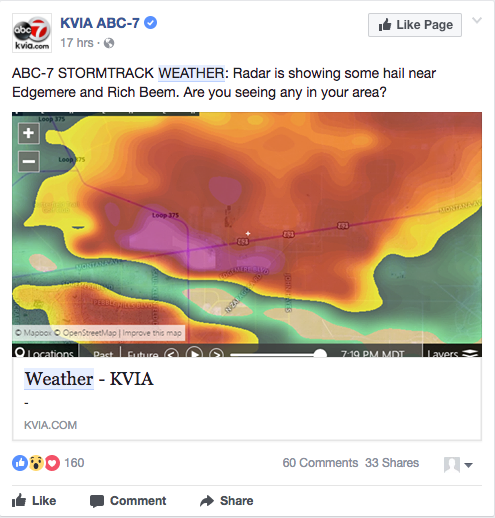Now that we have officially entered hurricane season, I started thinking about the correlation between weather (a passive hobby) and social media (my day job). To be more specific, does it make sense to use social media as a warning system when danger is imminent?
Recommended Social Sharing Weather
The American Meteorological Society (AMS) issued best practices for the dissemination of weather-related information to the general public earlier this year. They recommend official sources of weather (organizations in the business of providing weather information to a specific audiences):
- Differentiate between short-range forecasts, extended-range forecasts, and outlooks
- Recognize the limitations of numerical weather predictions
- Communicate uncertainty and be transparent
- Carefully and responsibly craft headlines and key messages
- Offer a schedule for updates
- Include NOAA watch, warning, and advisory products or hazardous weather outlooks
- Use discretion when disagreeing with “official” NOAA forecasts, especially during high-impact events
- Alert the public about appropriate response to severe weather events
- Include climatology information
- Identify where and when weather data originated and provide appropriate credit
- Provide links to other relevant data
That’s a lot of information to include in a 140-character tweet!
Real Social Sharing Weather
Following are social media posts I found on various channels pertaining to recent weather events:
Twitter: Local church service announcement.

Facebook: Local news station soliciting feedback (they received 60 comments & 33 shares as of June 7)

Instagram: UGC – man finishing mowing his grass while a tornado rages in the background.

YouTube: Documentary about Tornados in Texas as reported by the National Weather Service from Dec. 21 to Dec. 27. The seven-day streak was the most consecutive days with tornadoes on record in the month of December, according to TNT channel.
Implementing Social Sharing Weather
The National Weather Service, a pioneer in digital communications across the federal government, has been using social media to share weather updates with the public for several years (platform went live in June 2014), honing which messages are delivered to which channels. “… YouTube, which is used for briefings, Twitter, which is more of the short-term, what you need to know right now, and Facebook, which we are trying to use as more of a heads up, this is what we are expecting over the next few hours,” said James Morrow, meteorologist with the Weather Service, in a recent article from wtvf.org.
Of course, the downside to providing weather updates via social media is “They stoke unnecessary fear, paralyze the public into a state of panic and ultimately are a disservice to the otherwise reliable forecasts issued by the National Weather Service and other credible forecast agencies,” said Michael Lowry, hurricane expert at The Weather Channel. Lowry is referencing spaghetti plots, used to predict paths a hurricane may take over time.
The overall consensus, aside from the intended misuse of weather-related social media posts, is that using social media to inform and/or warn the public about imminent events is in everyone’s best interest. Given that our smartphones are one of our most prized possessions, we are always within arms’ length of breaking weather news.
If you are responsible for reporting weather-related events and would like to learn more about including social media on your digital channels, please contact Crowdynews. We will be happy to provide you with a free evaluation and demonstration of social sharing weather events.
Below is an example of a live weather-related, social media stream.